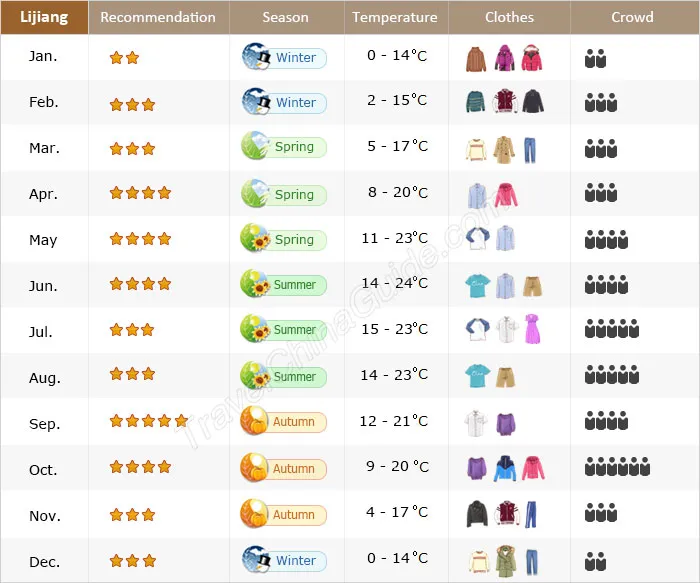Best Time to Visit Lijiang
Due to the high altitude and low latitude, Lijiang has small temperature differences, hence it is suitable for visiting all year round. Even then, April to June and September to November are considered the best times to visit Lijiang as the weather is more pleasant. July and August have frequent heavy rains while in winter after November, it is a bit cold.
 |
Peak Season: May to October
During the peak season, there is a noticeable increase in the cost of accommodations, and many inns and hotels are fully booked, thus it is very important for tourists to reserve rooms in advance. Also, you may encounter tourist crowds at some famous scenic spots.
Slack Season: November to April
Considering the low rainfall, fewer tourists and lower cost, Nov. to Apr. may be the best time to visit Lijiang for people on a limited budget. However, when visiting attractions at high altitude, tourists are advised to bring warm clothes, aspirin, sunglasses, sun-scream, hat and lip balm to prevent altitude sickness and protect against strong ultraviolet rays and the cold.
Times to Avoid Travel
We strongly recommend that overseas tourists avoid visiting Lijiang during Chinese public holidays, particularly during the Chinese New Year and the National Day holiday. During these two seven-day holidays, accommodation costs usually double or even triple. Service may be inferior and the sightseeing experience may not be as good. Other public holidays thatt should be avoided include the Qingming Festival, May Day, and the Dragon Boat Festival.
![]() See More about Public Holidays in China.
See More about Public Holidays in China.
Travel to Lijiang in Four Seasons
Spring: March to May
Spring in Lijiang is sunny but with large daily temperature difference of around 12℃ (54℉)
Average temperature: 8 - 17℃ (46 - 63℉)
Clothes: windbreaker, jacket, hoodie, thin sweater
On sunny spring days, many tourists like to take their camera and go to the Jade Spring Park, the best place to photograph the snow capped Jade Dragon Snow Mountain. Another must is to enjoy the blooming red camellias at the Yufeng Temple. The colorful Thang-ga murals inside are also worth seeing. Since it barely rains in spring, taking a tram to visit the Lugu Lake is a popular outdoor activity. The peaceful plateau lakes and lofty mountains are really unforgettable. Aside from the natural scenery, tourists may experience local customs at the Shuhe Ancient Temple. While wandering through the traditional residences of the Naxi people, tourists can see how they process leather or bamboo products, and taste the delicious local food.
Summer: June to August
Summer is the rainy season in Lijiang, and the weather is very unstable.
Average temperature: 14 - 23℃ (57 - 73℉)
Clothes: T-shirt, blouse, long sleeve shirt, thin jacket
Thanks to the abundant rainfall, July and August are the best months to visit Lijiang’s rivers and gorges. At the Tiger Leaping Gorge, tourists will be impressed by the surging water pounding on the mountain rocks. However, a totally different scene can be enjoyed at the First Bend of the Yangtze River. Despite the change in the direction of flow, this section still looks peaceful and soothing. Lastly, tourists should not miss the top attraction here, Lijiang Old Town. Everyone falls in love with it at their first sight of the wooden buildings, stone paved streets, delicate bridges and gurgling creeks. During the visit, tourists may learn about Naxi music, clothes, embroidery, pottery and carvings.
Autumn: September to November
Autumn in Lijiang is cool with intermittent rains.
Average temperature: 8 - 19℃ (46 - 66℉)
Clothes: shirt, jacket, hoodie, cardigan
Clear and mild autumn is the Lijiang best time to visit Blue Moon Valley and Ganhaizi hidden among Jade Dragon Snow Mountain. On sunny days, the lakes in Blue Moon Valley look extremely clear, and the whole valley looks like a blue crescent from a distance. Ganhaizi, which is actually a dry sea meadow, is a good place to enjoy the panorama of the snowy mountains. Another recommended attraction is Mu’s Residence. The ancient buildings inside represent the royal architectural style of the Ming Dynasty (1368-1644), quite different from the vibe of the Lijiang Old Town. Speaking of which, if visitors wanting a less crowded old town and an opportunity to learn about Naxi culture, should be sure to visit Yuhu Village and Baisha Village.
Winter: December to February
Winter in Lijiang is dry, windy and a little cold. The difference between the day and night temperatures increases to 14℃ (57℉).
Average temperature: 0 - 14℃ (32 - 57℉)
Clothes: down jacket, overcoat, sweater, padded trousers
Undoubtedly, Jade Dragon Snow Mountain boasts the best snow view in Lijiang in winter. Tourists may take cableways to enjoy the plain view of stretching glaciers. At the middle of the main peak is Spruce Plateau. Green spruce trees, yellow grasslands and white snow make an amazing background for tourists to take photos. Migratory birds also agree that Dec. to Feb. is the best time to visit Lijiang, and Lashi Lake provides them shelter from cold current. Tourists can enjoy the view of birds frolicking in the grass or picking up fish from the water. If time permits, one may feel Lijiang's slow-paced life at the Zhongyi Market. Foods sold here are fresh and delicious.